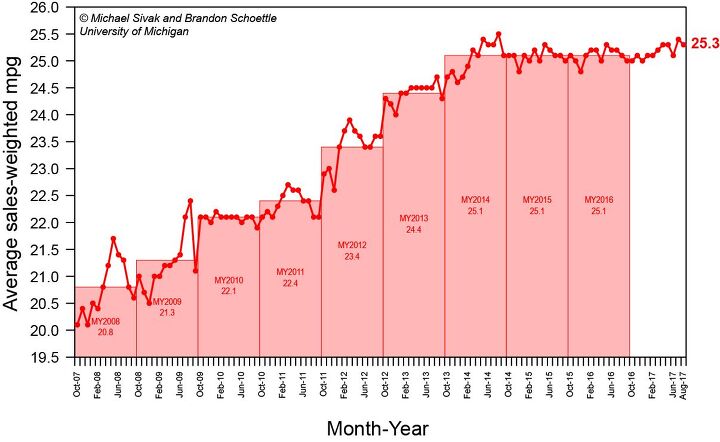U.S. Average Fuel Economy Down in August, Up for End of Summer: Study

The average fuel economy of new cars and light trucks sold within the United States in August was 25.3 mpg, down a very modest 0.1 mpg from July. Based on data plotted by the University of Michigan Transportation Research Institute, that represents an overall increase for the summer months — though it’s been a few years since we’ve seen a meaningful net gain.
Peak efficiency occurred in August of 2014, when fuel economy averaged 25.5 mpg. Since then, it’s been a herky-jerky series of minor rises and falls — ultimately resulting in an annual stagnation. Lower gas prices, combined with a growing preference for crossovers and SUVs, has kept the yearly economy average at 25.1 mpg.
While it’s too early to say anything definitive, the 2017 model year looks to be the first 12-month production period to yield an overall improvement since 2014. It won’t be dramatic, however. Average fuel economy shot up 5.2 mpg between the 2007 model year and 2014 but, if we’re being generous, the best this year is likely to see amounts to a few tenths of a mile per gallon.
According to Automotive News’ Data Center, year-over-year U.S. light-vehicle deliveries dropped 1.8 percent in August — with car sales descending 9.5 percent as pickups and crossovers rose 3.7 and 4.8 percent, respectively.
It’s important to remember that the University of Michigan Transportation Research Institute’s data is sales-weighted. Were consumers not buying larger and less economical vehicles, we would have seen larger economy gains over the last few years. But the research tabulates a real-world average based upon consumer choices, rather than an idealistic scenario where the name number of people buy a Toyota Prius and Ford’s F-Series.
If you’re curious, the entire Prius family garnered 9,551 U.S. deliveries in August against the F-Series’ 77,007. That represents a roughly 66-percent decline for Toyota’s hybrid compared to August of 2013, and just another strong month for Ford.
Change could be coming, however. The rise in average fuel economy has shadowed the price of gasoline. A typical gallon of regular gasoline was $2.661 on Wednesday, up from $2.199 a year ago, according to AAA data. Should the trend continue, smaller cars could become more attractive to new car buyers.
[Graph: University of Michigan]

A staunch consumer advocate tracking industry trends and regulation. Before joining TTAC, Matt spent a decade working for marketing and research firms based in NYC. Clients included several of the world’s largest automakers, global tire brands, and aftermarket part suppliers. Dissatisfied with the corporate world and resentful of having to wear suits everyday, he pivoted to writing about cars. Since then, that man has become an ardent supporter of the right-to-repair movement, been interviewed on the auto industry by national radio broadcasts, driven more rental cars than anyone ever should, participated in amateur rallying events, and received the requisite minimum training as sanctioned by the SCCA. Handy with a wrench, Matt grew up surrounded by Detroit auto workers and managed to get a pizza delivery job before he was legally eligible. He later found himself driving box trucks through Manhattan, guaranteeing future sympathy for actual truckers. He continues to conduct research pertaining to the automotive sector as an independent contractor and has since moved back to his native Michigan, closer to where the cars are born. A contrarian, Matt claims to prefer understeer — stating that front and all-wheel drive vehicles cater best to his driving style.
More by Matt Posky
Latest Car Reviews
Read moreLatest Product Reviews
Read moreRecent Comments
- Jkross22 When I think about products that I buy that are of the highest quality or are of great value, I have no idea if they are made as a whole or in parts by unionized employees. As a customer, that's really all I care about. When I think about services I receive from unionized and non-unionized employees, it varies from C- to F levels of service. Will unionizing make the cars better or worse?
- Namesakeone I think it's the age old conundrum: Every company (or industry) wants every other one to pay its workers well; well-paid workers make great customers. But nobody wants to pay their own workers well; that would eat into profits. So instead of what Henry Ford (the first) did over a century ago, we will have a lot of companies copying Nike in the 1980s: third-world employees (with a few highly-paid celebrity athlete endorsers) selling overpriced products to upper-middle-class Americans (with a few urban street youths willing to literally kill for that product), until there are no more upper-middle-class Americans left.
- ToolGuy I was challenged by Tim's incisive opinion, but thankfully Jeff's multiple vanilla truisms have set me straight. Or something. 😉
- ChristianWimmer The body kit modifications ruined it for me.
- ToolGuy "I have my stance -- I won't prejudice the commentariat by sharing it."• Like Tim, I have my opinion and it is perfect and above reproach (as long as I keep it to myself). I would hate to share it with the world and risk having someone critique it. LOL.



































Comments
Join the conversation
I wish stories on TTAC about industry MPG would mention if the cited average refers to CAFE MPG or Window-Sticker MPG; the two numbers are very different. I wouldn't expect a general-purpose news outlet to make the distinction, but a specialty publication that very frequently writes articles about industry trends in fuel economy should make the effort to do so. (For starters, the govt's CAFE targets look a lot more reasonable when you realize they are a lot easier to make than if we were to use window-sticker MPG.)
No doubt such articles will soon be a thing of the past when everyone starts driving around in a Tesla model 3 - just have to wait a few more months for production to ramp up and shazam - everyone will be running on electrons.